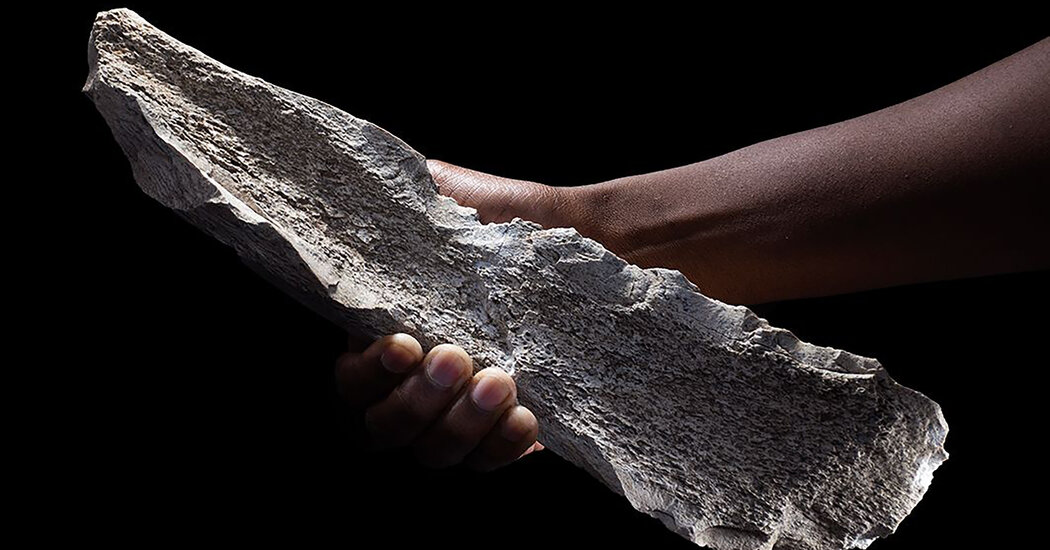Humans, unlike most other species, have a knack for making tools.
Six million years ago, our apelike ancestors probably smashed nuts with rocks or caught termites with sticks. Around 3.3 million years ago, hominins began using flakes of stone, perhaps to cut flesh from carcasses or chop plants.
And by 1.5 million years ago, they were using more sophisticated tools made of bone, according to a new study published in Nature, which dates the systematic use of bone tools to a million years earlier than archaeologists had previously thought.
Ignacio de la Torre, an archaeologist at the Spanish National Research Council who led the research, said the discovery made him wonder what is left to be discovered. “We may be missing a whole world of tools made by early humans,” he said.
Dr. de la Torre has spent years exploring Tanzania, in East Africa, to investigate the early stages of human tool-making. Before 1.8 million years ago, hominins simply knocked one rock against another to split off a sharp-edged flake. But after that point, they crafted a diverse array of stone tools.
One type, known as a hand ax, is a large, teardrop-shaped stone with a double-sided edge. Hominins also made cleavers and scrapers from bone. These tools — known as Acheulean technology — suggest that hominins gained an ability to conceptualize the shape of a complex tool and then sculpt a rock to bring it into existence.
In 2015, Dr. de la Torre and his colleagues began digging a trench in a gully known as the T69 Complex, where they had previously found Acheulean stone tools on the ground. They hoped to find more of them embedded in the rock below, perhaps alongside bones and other clues to how hominins were using those tools.
They indeed found thousands of fossils of hippopotamuses, crocodiles and fish — animals that had lived in a pond or lake some 1.5 million years ago. The researchers discovered cut marks on the hippo bones as well as more than 10,000 stone tools. They did not find any fossils of the hominins who scavenged the animals, but judging from similar sites nearby, they suspected Homo erectus — a tall, bipedal hominin — was responsible for the butchering.
Then, in 2018, the scientists unearthed a surprise in their trench. As described in the new study, they found a hand ax, made not from stone but from elephant bone.
To create the hand ax, hominins must have found an elephant carcass and smashed one of its massive limbs. Then, after breaking off a bone fragment, they gave it a sharp cutting edge.
Before this discovery, researchers had only found a few bones at other sites in East Africa. In 2020, for example, researchers reported finding a hand ax in Ethiopia dating back 1.4 million years, made from a hippo’s femur.
Compared with thousands of stone tools that had been found, bone tools were so rare that it was hard to know what to make of them.
“We were not expecting at all that these humans were making bone tools,” Dr. de la Torre said. “It led us to think there might be others.”
So the researchers dug a much bigger trench and found more bone tools, some from elephants and others from hippos. The researchers then looked back at pieces of bones they had previously unearthed, which they had assumed were just fragments broken open by hominins to eat the marrow inside. On closer inspection, they could see that some of those remains were tools as well.
In total, Dr. de la Torre and his colleagues found 27 bone tools, some as long as 15 inches. They were not rarities that hominins created once every 100,000 years: The scientists found all the tools in the same 20-inch-thick layer of sandstone, suggesting they were all used in a period of “dozens of years,” he said.
“One of the genuinely exciting things about the paper is that there are so many of these things in the same site, and that is genuinely unusual,” said James Clark, an archaeologist at the University of Cambridge who was not involved in the study. The hominins living there, he said, “clearly are very comfortable working with bone, and they’re clearly very familiar with doing it.”
They also seemed to plan how to use them in advance. Eight of the tools came from elephant bones, and yet the researchers found no trace of an elephant carcass. Dr. de la Torre said it was likely that the hominins had crafted the elephant-bone tools somewhere else.
He speculated that the brains of hominins in this era were already so sophisticated that they could do more than just apply the image of a particular tool to any rock lying around. They went to extra lengths to obtain the bones and then turn them into tools.
Dr. de la Torre said it was likely that other troves of bone tools await archaeologists at other ancient sites in Africa.
“It may be the case that we archaeologists have not looked hard enough, with the right eyes,” he said.


